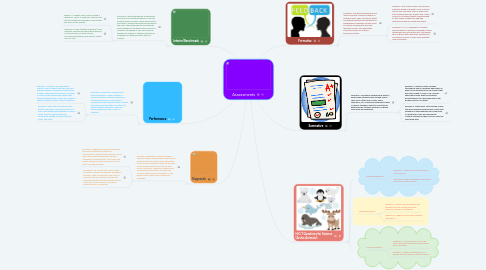
1. Interim/Benchmark
1.1. Definition: Interim/Benchmark Assessments are used to see student progress in specific content areas and ideas. These assessments are given to students periodically throughout the class. Interim/Benchmark assessments allow teachers to see what overall concept a student is struggling in. This can allow the teachers to reteach or change instructional strategies for teaching certain parts of content.
1.1.1. Example 1: Chapter Tests; After reading a chapter of a book or textbook, teachers can test the students knowledge of the content discussed in the chapter.
1.1.2. Example 2: Essay (Written Response); Give students a prompt and have them respond to the prompt in an essay format. Discussing what they know about a certain topic or idea.
2. Performance
2.1. Definition: Performance Assessments require students to show mastery of content through creating something, or through performance. Performance Assessments show teachers what students understand and how they can apply it to different things and ideas. These are always graded by using a rubric or checklist.
2.1.1. Example 1: Portfolio; Students gather previous work of theirs that they feel best exhibits mastery of different content areas or ideas. They present their work in a binder or online to the teacher and explain why they feel these pieces of work they selected exhibits mastery of the content in question.
2.1.2. Example 2 Short Skit; Students get into groups and create a skit around a topic or idea. The students work together to write a script, come up with background information needed to understand the script, and more.
3. Diagnostic
3.1. Definition: Diagnostic Assessments help teachers identify the gaps and differences in what the students already know when they come to their classroom. These can be used as pre-assessments before starting new units or concepts. Diagnostic Assessments will help teachers determine what areas students might need extra support in, and where others might need an additional challenge.
3.1.1. Example 1: Diagnostic Questionnaire; these are quick and efficient Diagnostic Assessments. Students check boxes of areas they enjoy, and what they feel are their strengths and weaknesses. If you make the results anonymous than students are more likely to answer honestly.
3.1.2. Example 2: Pre-Course Test Exams; these can often be found in textbooks supplied to teachers. They ask questions over units or chapters that are about to be studied to determine what the student already knows. These can be very helpful if you teach heavily relying on textbooks.
4. Formative
4.1. Definition: Formative Assessments are used to monitor students progress in different areas. They can help students and teachers determine strengths and weaknesses in different content areas. Formative Assessments also help teachers monitor and adjust their instruction based on student performance data.
4.1.1. Example 1: Exit Tickets; after a lesson have students answer a question of your choice before they can leave class or before you start teaching the next subject area. These allow you to gauge student understanding as well as gain insight into what the students thought of a particular lesson.
4.1.2. Example 2: 3-2-1 Countdowns; Students respond either in writing or speaking to three things they did not know before, two things that surprised them about the content and one thing you want to start doing with this new information.
5. Summative
5.1. Definition: Summative Assessments want to assess what students have learned overall. They occur at the end of units, years, semesters, etc. Summative Assessment data is used by teachers, districts, and states to determine the students accuracy on grade level goals and objectives.
5.1.1. Example 1: Midterm Exams; halfway through the year or semester administer an exam to the students over the content that has been taught in class so far. This will show the teacher what the students know/retained from the beginning to the halfway mark on a subject.
5.1.2. Example 2: State Tests; Tests like the STAAR test are summative assessments. These test students on the standards set by the state to determine if they are learning the content required for them to move onto the next grade level.
6. H.O.T Questions for Science (Arctic Animals):
6.1. Opening Questions:
6.1.1. Question 1: What are some examples of arctic animals?
6.1.2. Question 2: What is something you want to learn about arctic animals?
6.2. Guiding Questions:
6.2.1. Question 1: What is similar between the penguins we just read and the polar bears we read about yesterday?
6.2.2. Question 2: What are some ways penguins stay warm?
6.3. Closing Questions:
6.3.1. Question 1: If you had to be one of the arctic animals we discussed, which would you be and why?
6.3.2. Question 2: What is something we, as humans need to survive in arctic climates?
